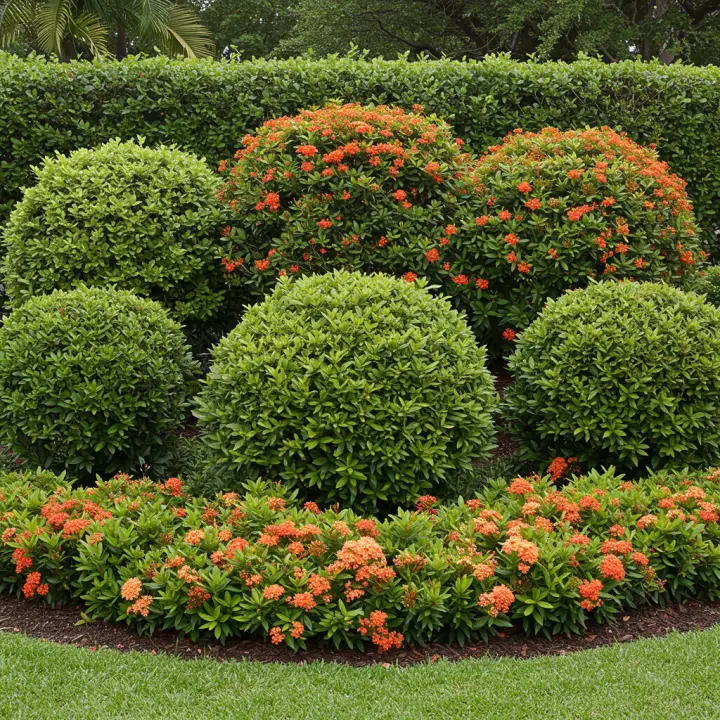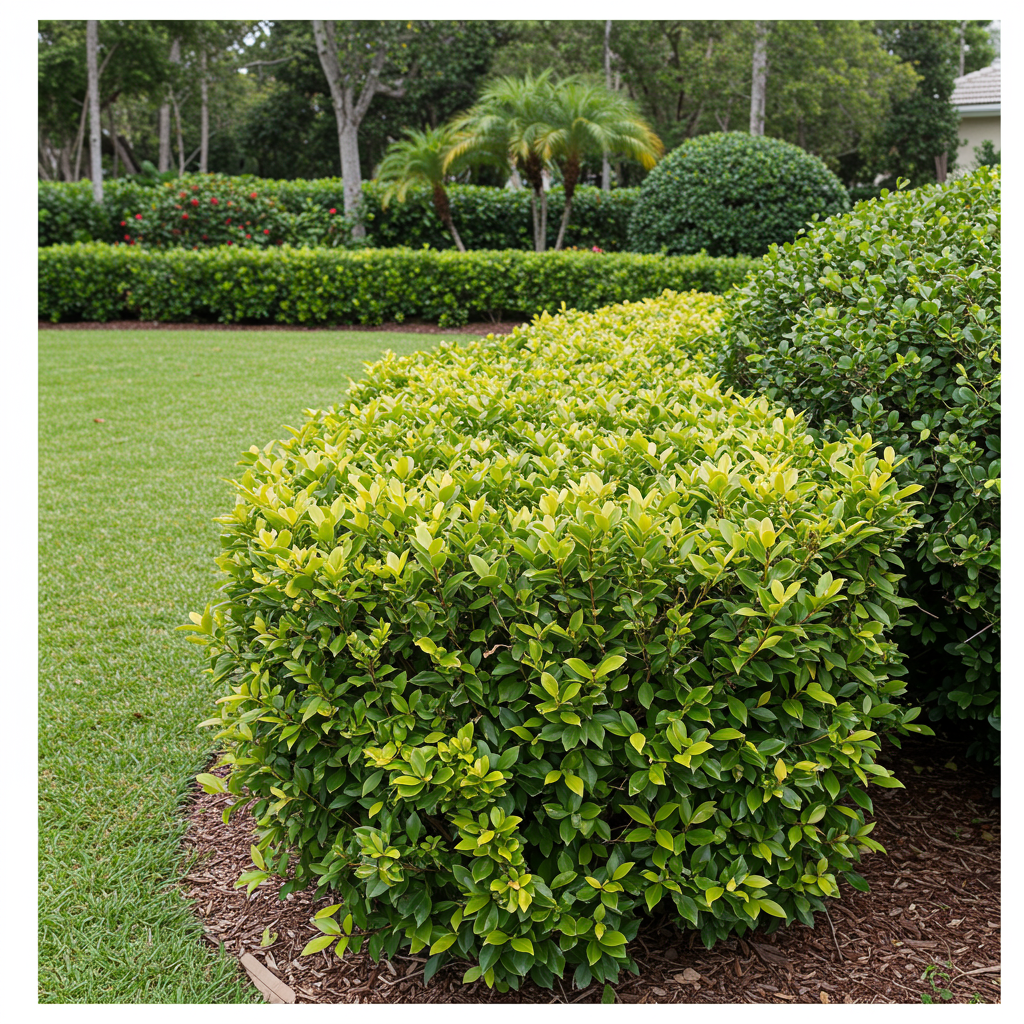Transform your South Florida landscape with the best hedges South Florida has to offer – stunning, easy-care varieties that thrive in our unique climate. This comprehensive guide highlights top picks for beauty, privacy, and low maintenance, ensuring your outdoor space is both beautiful and functional.
Why Choose Hedges for Your South Florida Landscape?

Hedges are more than just green walls; they are living boundaries that add structure, beauty, and privacy to any yard. In South Florida’s vibrant, often dense, communities, a well-chosen hedge can be invaluable. They can offer a natural screen from neighbors, a windbreak against sea breezes, reduce noise, and even enhance curb appeal, increasing your property’s value. From creating a lush backdrop for a flower bed to defining garden rooms, the possibilities are endless.
Navigating South Florida’s Unique Climate: What to Consider
South Florida presents a unique set of challenges and opportunities for garden enthusiasts. Our tropical to subtropical climate boasts high humidity, abundant sunshine, and warm temperatures year-round. However, we also contend with sandy soils, potential salt exposure (especially near the coast), and the occasional hurricane. When selecting the best hedges for South Florida, keep these factors in mind:
Sunlight: Most South Florida hedges thrive in full sun (6+ hours daily).
Soil Type: Our sandy soils often require amendments to improve water retention and fertility.
Water Needs: While some are drought-tolerant once established, many appreciate regular watering.
Mature Size: Consider the plant’s ultimate height and width to avoid constant pruning.
Growth Rate: Fast-growing hedges offer quick privacy but require more frequent trimming.
Salt Tolerance: Crucial for coastal properties.
Maintenance: How much time are you willing to dedicate to pruning, fertilizing, and pest control?
Our Top Picks: The Best Hedges South Florida Has to Offer
Ready to find your perfect green screen? Here are some of the most stunning and easy-to-grow hedges that flourish in South Florida.
Privacy Powerhouses: Fast-Growing & Dense Hedges
For those seeking quick privacy and a solid green barrier, these options are champions.
Green Island Ficus (Ficus microcarpa ‘Green Island’)
Why it’s great: A classic for a reason. Green Island Ficus is renowned for its rapid growth, dense foliage, and ability to be tightly pruned into formal shapes. It provides excellent privacy and a clean, manicured look.
Care: Loves full sun, consistent water, and regular fertilization. Requires frequent pruning to maintain shape.
Considerations: Can become very large if not maintained. Roots can be invasive.
Clusia (Clusia guttifera or Clusia rosea ‘Nana’)
Why it’s great: An incredibly tough and versatile plant, Clusia offers thick, leathery leaves and a robust growth habit. It’s salt-tolerant and drought-tolerant once established, making it ideal for coastal areas and low-maintenance landscapes. The ‘Nana’ variety is more compact.
Care: Thrives in full sun to partial shade. Very forgiving with water.
Considerations: Can grow quite wide; ensure adequate space.
Podocarpus (Podocarpus macrophyllus)
Why it’s great: A sophisticated choice offering a refined, columnar look. Podocarpus plants are excellent for formal hedges, providing dense screening with their narrow, evergreen leaves. They are tolerant of various conditions and can be pruned into very precise shapes.
Care: Prefers full sun to partial shade. Needs good drainage. Moderate growth rate.
Considerations: Slower growing than Ficus, but offers a more elegant texture.
Areca Palm (Dypsis lutescens)
Why it’s great: For a tropical, softer privacy screen, the multi-stemmed Areca Palm is a stellar choice. Its feathery fronds create a lush, airy barrier.
Care: Prefers partial shade to full sun. Needs consistent moisture and protection from strong winds if very exposed.
Considerations: Not as dense as traditional hedges but offers a beautiful, resort-like feel.
Visually Stunning: Flowering Hedges for Beauty
For those who want a burst of color along with their green, these flowering hedges deliver.
Ixora (Ixora coccinea)
Why it’s great: A tropical showstopper with vibrant clusters of red, orange, pink, or yellow flowers almost year-round. Ixora forms a dense, compact hedge that adds spectacular color.
Care: Loves full sun, acidic soil, and consistent moisture. Requires fertilization to keep blooms coming.
Considerations: Can be sensitive to alkaline soil and cold snaps.
Hibiscus (Hibiscus rosa-sinensis)
Why it’s great: The quintessential tropical flower, Hibiscus can be pruned into a stunning, informal hedge. Its large, colorful blooms attract hummingbirds and butterflies.
Care: Full sun, well-draining soil, and consistent watering. Needs regular deadheading and pruning to encourage more blooms and maintain shape.
Considerations: Can be prone to pests like aphids and scale.
Bougainvillea (Bougainvillea glabra)
Why it’s great: With its spectacular, long-lasting bracts (often mistaken for flowers), Bougainvillea creates an impenetrable, thorny, and incredibly colorful barrier. It’s drought-tolerant and thrives in heat.
Care: Full sun is essential for abundant blooms. Needs minimal water once established.
Considerations: Thorny branches require careful handling during pruning. Can be very vigorous.
Low Maintenance Wonders: Easy Care Hedges
If you prefer a hands-off approach, these hedges are wonderfully resilient and forgiving.
Natal Plum (Carissa macrocarpa)
Why it’s great: This tough, native-friendly plant offers glossy green leaves, fragrant white flowers, and edible red fruit. It’s extremely drought-tolerant, salt-tolerant, and handles tough conditions with ease, making it a truly easy-care option. Its thorns also provide a good security deterrent.
Care: Full sun to partial shade. Requires very little water once established.
Considerations: Pruning is necessary to maintain shape and can be tricky due to thorns.
Cocoplum (Chrysobalanus icaco)
Why it’s great: A fantastic native option, Cocoplum is highly salt-tolerant and adaptable to various conditions. It forms a dense, natural hedge with attractive rounded leaves. It also produces edible, plum-like fruit.
Care: Full sun to partial shade. Tolerates a range of soils and moisture levels.
Considerations: Slightly slower growing than other main privacy hedges but incredibly resilient.
Essential Care Tips for Thriving South Florida Hedges
Even the easiest hedges benefit from proper care to look their best and stay healthy.
Planting: Dig a hole twice as wide as the root ball but no deeper. Ensure good drainage.
Watering: Water thoroughly after planting. Establish a watering schedule based on rainfall and plant needs; most need consistent water during their first year. Once established, many become more drought-tolerant.
Fertilizing: Use a slow-release granular fertilizer formulated for South Florida plants (often containing micronutrients) 2-3 times a year, typically in spring, summer, and fall.
Pruning: Regular pruning is key to maintaining shape and density. Use sharp, clean tools. For formal hedges, prune more frequently. For informal hedges, selective pruning to remove dead or unruly branches might suffice.
* Pest & Disease: Monitor for common South Florida pests like aphids, scale, or whiteflies. Address issues promptly with appropriate organic or chemical treatments. Healthy, well-cared-for plants are less susceptible.
Frequently Asked Questions About South Florida Hedges
How fast do hedges grow in South Florida?
Growth rates vary significantly by species. Green Island Ficus and Clusia are known for fast growth (1-3 feet per year), while Podocarpus and Cocoplum grow at a moderate pace (6-12 inches per year).
What is the best hedge for privacy in South Florida?
For dense, quick privacy, Green Island Ficus and Clusia are top contenders. Podocarpus offers dense privacy with a more refined texture, albeit at a slightly slower pace.
Are there native hedges suitable for South Florida?
Yes! Cocoplum (Chrysobalanus icaco) and Natal Plum (Carissa macrocarpa) are excellent native-friendly choices that thrive in our local conditions and support local wildlife.
How often should I prune my South Florida hedge?
Fast-growing species like Ficus may need pruning every 4-6 weeks during growing season to maintain a formal shape. Slower growers might only need 2-3 trims per year. Always prune to shape, not to severe stress.
What hedges are best for salty coastal areas in South Florida?
Clusia (Clusia guttifera), Natal Plum (Carissa macrocarpa), and Cocoplum (Chrysobalanus icaco) are all excellent choices due to their high salt tolerance. Sea Grape (Coccoloba uvifera) can also be used as a large hedge.
Conclusion
Choosing the best hedges South Florida has to offer can dramatically enhance your property’s beauty, privacy, and functionality. By considering our unique climate and your specific needs, you can select varieties that will thrive with minimal fuss. Whether you desire a lush privacy screen, an explosion of color, or a low-maintenance green barrier, there’s a perfect hedge waiting for your South Florida landscape. Invest in the right plants, provide proper care, and watch your outdoor space transform into a stunning, verdant oasis.

